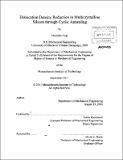| dc.contributor.advisor | Tonio Buonassisi. | en_US |
| dc.contributor.author | Vogl, Michelle (Michelle Lynn) | en_US |
| dc.contributor.other | Massachusetts Institute of Technology. Dept. of Mechanical Engineering. | en_US |
| dc.date.accessioned | 2012-01-30T17:05:51Z | |
| dc.date.available | 2012-01-30T17:05:51Z | |
| dc.date.copyright | 2011 | en_US |
| dc.date.issued | 2011 | en_US |
| dc.identifier.uri | http://hdl.handle.net/1721.1/68956 | |
| dc.description | Thesis (S.M.)--Massachusetts Institute of Technology, Dept. of Mechanical Engineering, 2011. | en_US |
| dc.description | Cataloged from PDF version of thesis. | en_US |
| dc.description | Includes bibliographical references (p. 77-78). | en_US |
| dc.description.abstract | Multicrystalline silicon solar cells are an important renewable energy technology that have the potential to provide the world with much of its energy. While they are relatively inexpensive, their efficiency is limited by material defects, and in particular by dislocations. Reducing dislocation densities in multicrystalline silicon solar cells could greatly increase their efficiency while only marginally increasing their manufacturing cost, making solar energy much more affordable. Previous studies have shown that applying stress during high temperature annealing can reduce dislocation densities in multicrystalline silicon. One way to apply stress to blocks of silicon is through cyclic annealing. In this work, small blocks of multicrystalline silicon were subjected to thermal cycling at high temperatures. The stress levels induced by the thermal cycling were modeled using finite element analysis (FEA) on Abaqus CAE and compared to the dislocation density reductions observed in the lab. As too low of stress will have no effect on dislocation density reduction and too high of stress will cause dislocations to multiply, it is important to find the proper intermediate stress level for dislocation density reduction. By comparing the dislocation density reductions observed in the lab to the stress levels predicted by the FEA modeling, this intermediate stress level is determined. | en_US |
| dc.description.statementofresponsibility | by Michelle Vogl. | en_US |
| dc.format.extent | 78 p. | en_US |
| dc.language.iso | eng | en_US |
| dc.publisher | Massachusetts Institute of Technology | en_US |
| dc.rights | M.I.T. theses are protected by
copyright. They may be viewed from this source for any purpose, but
reproduction or distribution in any format is prohibited without written
permission. See provided URL for inquiries about permission. | en_US |
| dc.rights.uri | http://dspace.mit.edu/handle/1721.1/7582 | en_US |
| dc.subject | Mechanical Engineering. | en_US |
| dc.title | Dislocation density reduction in multicrystalline silicon through cyclic annealing | en_US |
| dc.type | Thesis | en_US |
| dc.description.degree | S.M. | en_US |
| dc.contributor.department | Massachusetts Institute of Technology. Department of Mechanical Engineering | |
| dc.identifier.oclc | 773928797 | en_US |
